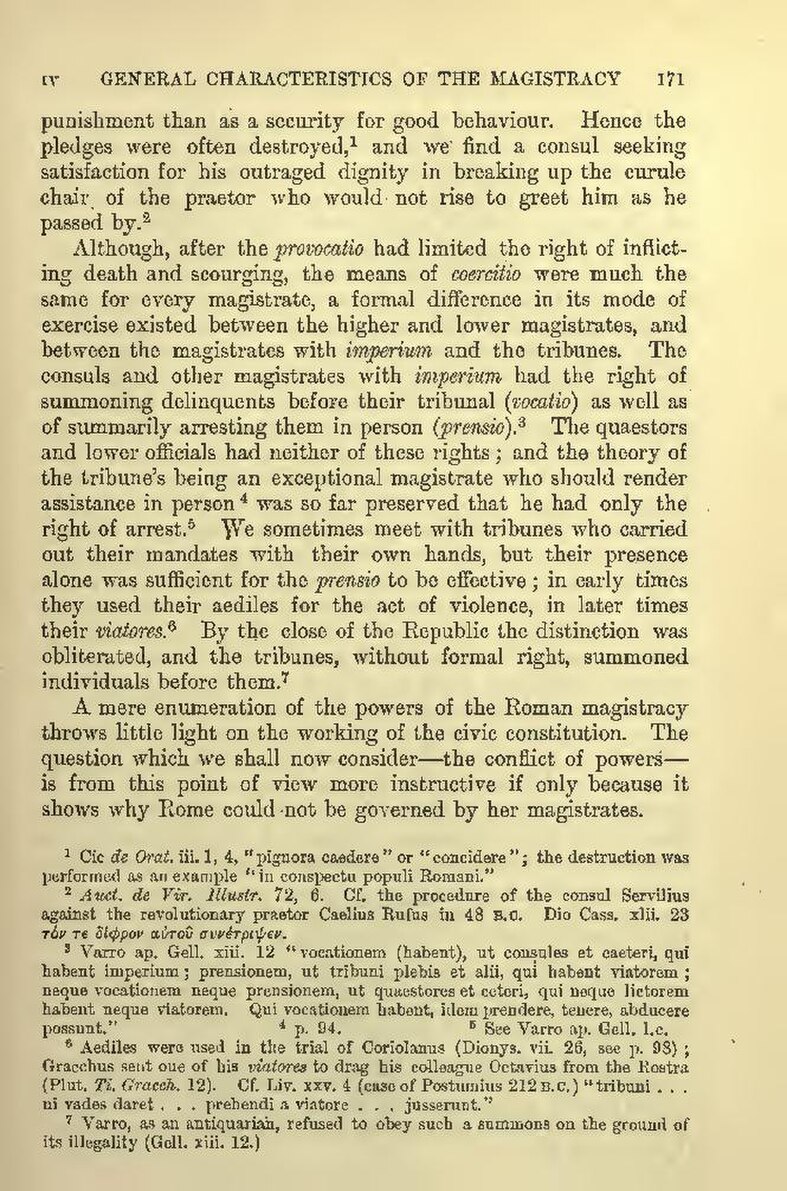punishment than as a security for good behaviour. Hence the pledges were often destroyed,[1] and we find a consul seeking satisfaction for his outraged dignity in breaking up the curule chair of the praetor who would not rise to greet him as he passed by.[2]
Although, after the provocatio had limited the right of inflicting death and scourging, the means of coercitio were much the same for every magistrate, a formal difference in its mode of exercise existed between the higher and lower magistrates, and between the magistrates with imperium and the tribunes. The consuls and other magistrates with imperium had the right of summoning delinquents before their tribunal (vocatio) as well as of summarily arresting them in person (prensio).[3] The quaestors and lower officials had neither of these rights; and the theory of the tribune's being an exceptional magistrate who should render assistance in person[4] was so far preserved that he had only the right of arrest.[5] We sometimes meet with tribunes who carried out their mandates with their own hands, but their presence alone was sufficient for the prensio to be effective; in early times they used their aediles for the act of violence, in later times their viatores.[6] By the close of the Republic the distinction was obliterated, and the tribunes, without formal right, summoned individuals before them.[7]
A mere enumeration of the powers of the Roman magistracy throws little light on the working of the civic constitution. The question which we shall now consider—the conflict of powers—is from this point of view more instructive if only because it shows why Rome could not be governed by her magistrates..]
- ↑ Cic de Orat. iii. 1, 4, "pignora caedere" or "concidere"; the destruction was performed as an example "in conspectu populi Romani."
- ↑ Auct. de Vir. Illustr. 72, 6. Cf. the procedure of the consul Servilius against the revolutionary praetor Caelius Rufus in 48 B.C. Dio Cass. xlii. 23 [Greek: ton te diphron autou synetripsen
- ↑ Varro ap. Gell. xiii. 12 "vocationem (habent), ut consoles et caeteri, qui habent imperium; prensionem, ut tribuni plebis et alii, qui habent viatorem; neque vocationem neque prensionem, ut quaestores et ceteri, qui neque lictorem habent neque viatorem. Qui vocationem habent, idem prendere, tenere, abducere possunt."
- ↑ p. 94.
- ↑ See Varro ap. Gell. l.c.
- ↑ Aediles were used in the trial of Coriolanus (Dionys. vii. 26, see p. 98); Gracchus sent one of his viatores to drag his colleague Octavius from the Rostra (Plut. Ti. Gracch. 12). Cf. Liv. xxv. 4 (case of Postumius 212 B.C.) "tribuni . . . ni vades daret . . . prehendi a viatore . . . jusserunt."
- ↑ Varro, as an antiquarian, refused to obey such a summons on the ground of its illegality (Gell. xiii. 12.)
